Evaluating Efficiency Improvement of Deep-Cut Curb Inlets for Road-Bioretention Stripes
Abstract
1. Introduction
2. Materials and Methods
2.1. Overland flow Simulation Model and Verification Cases
2.2. Modeling Cases for the Deep-Cut Curb Inlets
2.2.1. Determining 100% Interception Curb Inlet Lengths
2.2.2. Evaluating the Curb Inlet Efficiency
2.3. Modeling Cases for the Road-Curb Cut Curb Inlets
2.3.1. Determining 100% Interception Curb Inlet Lengths
2.3.2. Evaluating the Curb Inlet Efficiency
3. Results and Discussion
3.1. 100% Interception Curb Inlet Length for the Curb-Cut and Road-Curb Cut Scenarios
3.2. Curb inlet Efficiency for the Curb-Cut Scenarios
3.3. Curb inlet Efficiencies Evaluation for the Road-Curb Cut Scenarios
4. Conclusions
Author Contributions
Funding
Conflicts of Interest
Data availability
References
- Izzard, C.F. Tentative results on capacity of curb opening inlets. In Proceedings of the 29th Annual Conference of the Highway Research Board, Washington, DC, USA, 13–16 December 1950; Highway Research Board: Washington, DC, USA, 1950; pp. 11–13. [Google Scholar]
- Li, W.H. Hydraulic theory for design of stormwater inlets. In Proceedings of the 33rd Annual Meeting of the Highway Research Board, Washington, DC, USA, 12–15 January 1954; Highway Research Board: Washington, DC, USA, 1954; pp. 83–91. [Google Scholar]
- Brown, S.; Stein, S.; Warner, J. Urban Drainage Design Manual: Hydraulic Engineering Circular No. 22 (FHWA-NHI-10-009, HEC-22); National Highway Institute: Arlington, VA, USA, 2009. [Google Scholar]
- Hammonds, M.A.; Holley, E. Hydraulic Characteristics of Flush Depressed Curb Inlets and Bridge Deck Drains (FHWA/TX-96/1409-1); Texas Department of Transportation: Austin, TX, USA, 1995.
- Uyumaz, A. Urban drainage with curb-opening inlets. In Proceedings of the Ninth International Conference on Urban Drainage (9ICUD), Portland, OR, USA, 8–13 September 2002; American Society of Civil Engineers: Portland, OR, USA, 2002; pp. 1–9. [Google Scholar]
- Guo, J.C.Y.; MacKenzie, K. Hydraulic Efficiency of Grate and Curb-Opening Inlets under Clogging Effect (CDOT-2012-3); Colorado Department of Transportation, DTD Applied Research and Innovation Branch: Denver, CO, USA, 2012.
- Schalla, F.E.; Ashraf, M.; Barrett, M.E.; Hodges, B.R. Limitations of traditional capacity equations for long curb inlets. Transp. Res. Rec. J. Transp. Res. Board 2017, 2638, 97–103. [Google Scholar] [CrossRef]
- Fang, X.; Jiang, S.; Alam, S.R. Numerical Simulations of Efficiency of Curb-Opening Inlets. J. Hydraul. Eng. 2009, 136, 62–66. [Google Scholar] [CrossRef]
- Delestre, O.; Darboux, F.; James, F.; Lucas, C.; Laguerre, C.; Cordier, S. FullSWOF: A free software package for the simulation of shallow water flows. arXiv 2014, arXiv:1401.4125. [Google Scholar]
- Gourbesville, P.; Cunge, J.; Caignaert, G. Advances in Hydroinformatics-SIMHYDRO 2014, 1st ed.; Springer: Singapore, 2014; p. 624. [Google Scholar]
- Leandro, J.; Martins, R. A methodology for linking 2D overland flow models with the sewer network model SWMM 5.1 based on dynamic link libraries. Water Sci. Technol. 2016, 73, 3017–3026. [Google Scholar] [CrossRef] [PubMed]
- Li, X.; Fang, X.; Chen, G.; Gong, Y.; Wang, J.; Li, J. Evaluating curb inlet efficiency for urban drainage and road bioretention facilities. Water 2019, 11, 851. [Google Scholar] [CrossRef]
- Li, X.; Fang, X.; Gong, Y.; Li, J.; Wang, J.; Chen, G.; Li, M.H. Evaluating the road-bioretention strip system from a hydraulic perspective—Case studies. Water 2018, 10, 1778. [Google Scholar] [CrossRef]
- Li, X.; Fang, X.; Li, J.; KC, M.; Gong, Y.; Chen, G. Estimating time of concentration for overland flow on pervious surfaces by particle tracking method. Water 2018, 10, 379. [Google Scholar] [CrossRef]
- Unterweger, K.; Wittmann, R.; Neumann, P.; Weinzierl, T.; Bungartz, H.J. Integration of FullSWOF2D and PeanoClaw: Adaptivity and local time-stepping for complex overland flows. In Recent Trends in Computational Engineering-CE2014; Springer: Berlin/Heidelberg, Germany, 2015; pp. 181–195. [Google Scholar]
- Cordier, S.; Coullon, H.; Delestre, O.; Laguerre, C.; Le, M.H.; Pierre, D.; Sadaka, G. FullSWOF Paral: Comparison of two parallelization strategies (MPI and SKELGIS) on a software designed for hydrology applications. In ESAIM: Proceedings; EDP Sciences: Julius, France, 2013; pp. 59–79. [Google Scholar]
- Esteves, M.; Faucher, X.; Galle, S.; Vauclin, M. Overland flow and infiltration modelling for small plots during unsteady rain: Numerical results versus observed values. J. Hydrol. 2000, 228, 265–282. [Google Scholar] [CrossRef]
- Spaliviero, F.; May, R.; Escarameia, M. Spacing of Road Gullies: Hydraulic Performance of BS EN 124 Gully Gratings and Kerb Inlets; Highways Agency, HR Wallingford Ltd.: Wallingford, UK, 2000; pp. 99–107. [Google Scholar]
- Li, X.; Fang, X.; Wang, J.; Chen, G.; Li, J. Curb Inlet Efficiency Evaluation under Constant Rainfall and Upstream Inflow. In World Environmental and Water Resources Congress 2019: Water, Wastewater, and Stormwater; Urban Water Resources; and Municipal Water Infrastructure; American Society of Civil Engineers: Reston, VA, USA, 2019; pp. 20–33. [Google Scholar]
- Nash, J.; Sutcliffe, J.V. River flow forecasting through conceptual models part I—A discussion of principles. J. Hydrol. 1970, 10, 282–290. [Google Scholar] [CrossRef]
- MathWorks. MATLAB and Statistics Toolbox Release 2017a; The MathWorks Inc.: Natick, MA, USA, 2017. [Google Scholar]
- Gallaway, B.M.; Ivey, D.L.; Hayes, G.; Ledbetter, W.B.; Olson, R.M.; Woods, D.L.; Schiller, R.F., Jr. Pavement and Geometric Design Criteria for Minimizing Hydroplaning FHWA-RD-79-31; Federal Highway Administration, Offices of Research and Development: Washington, DC, USA, 1979.
- Stoolmiller, S.; Ebrahimian, A.; Wadzuk, B.M.; White, S. Improving the design of curb openings in green stormwater infrastructure. In Proceedings of the International Low Impact Development Conference, Nashville, Tennessee, 12–15 August 2018; pp. 168–176. [Google Scholar]
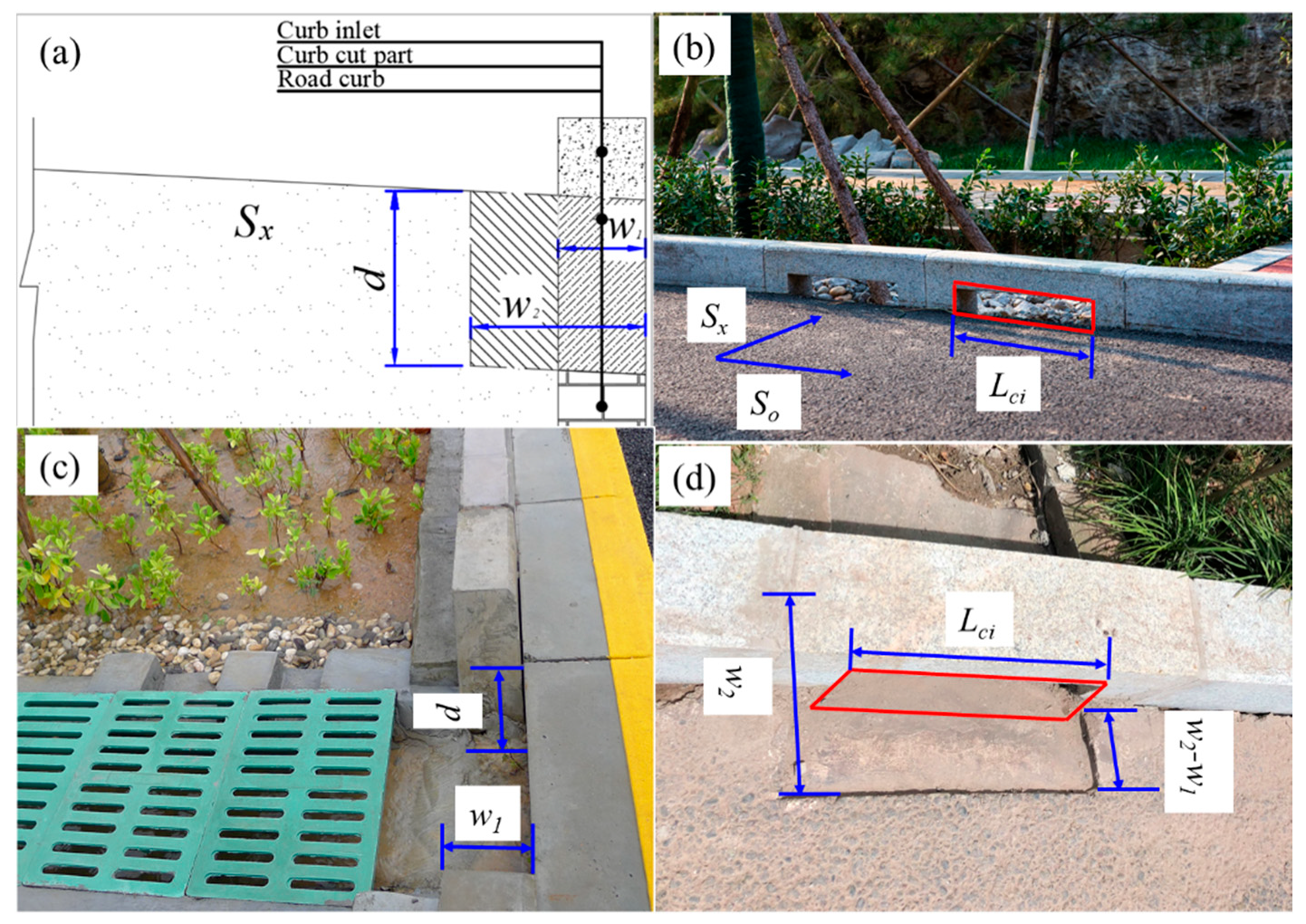
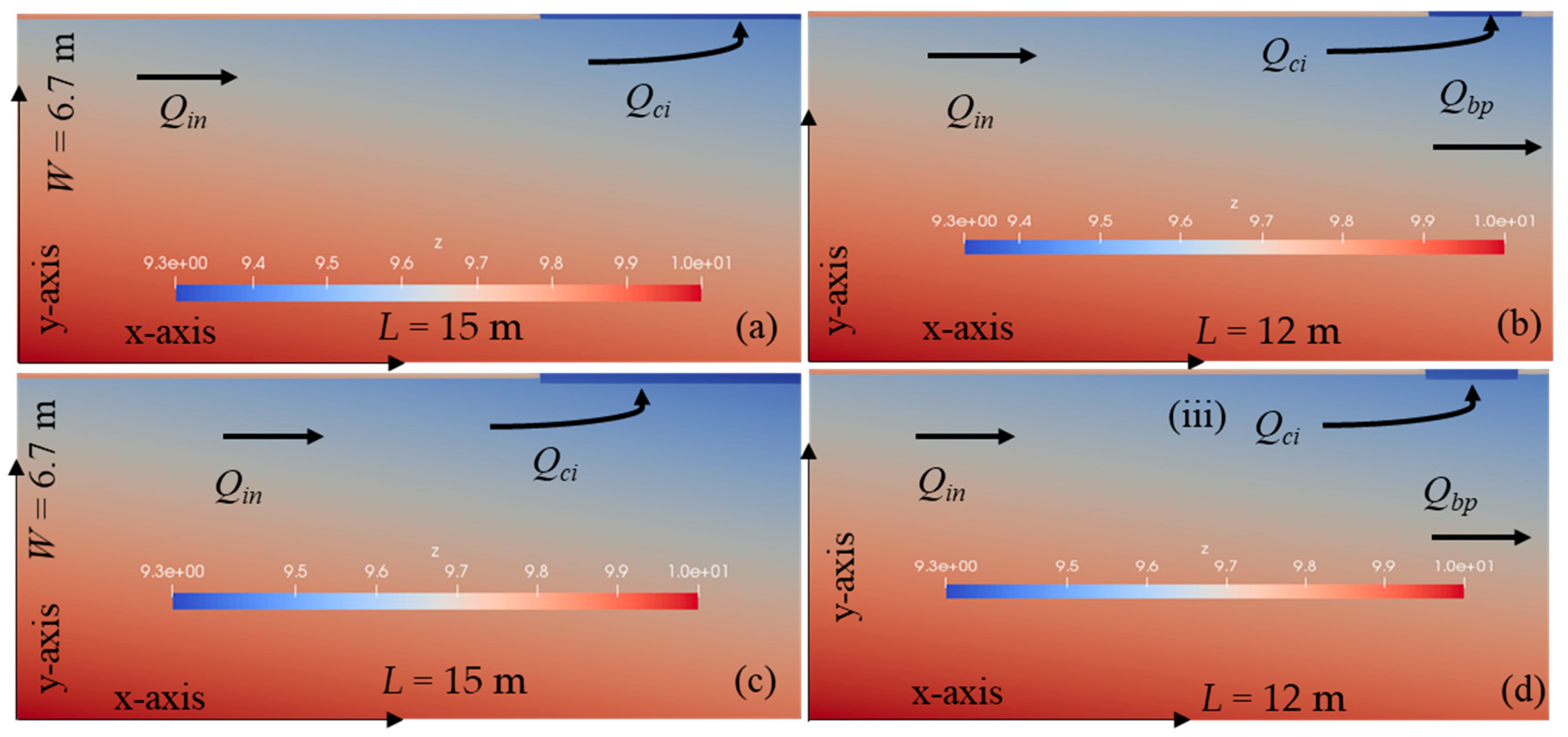
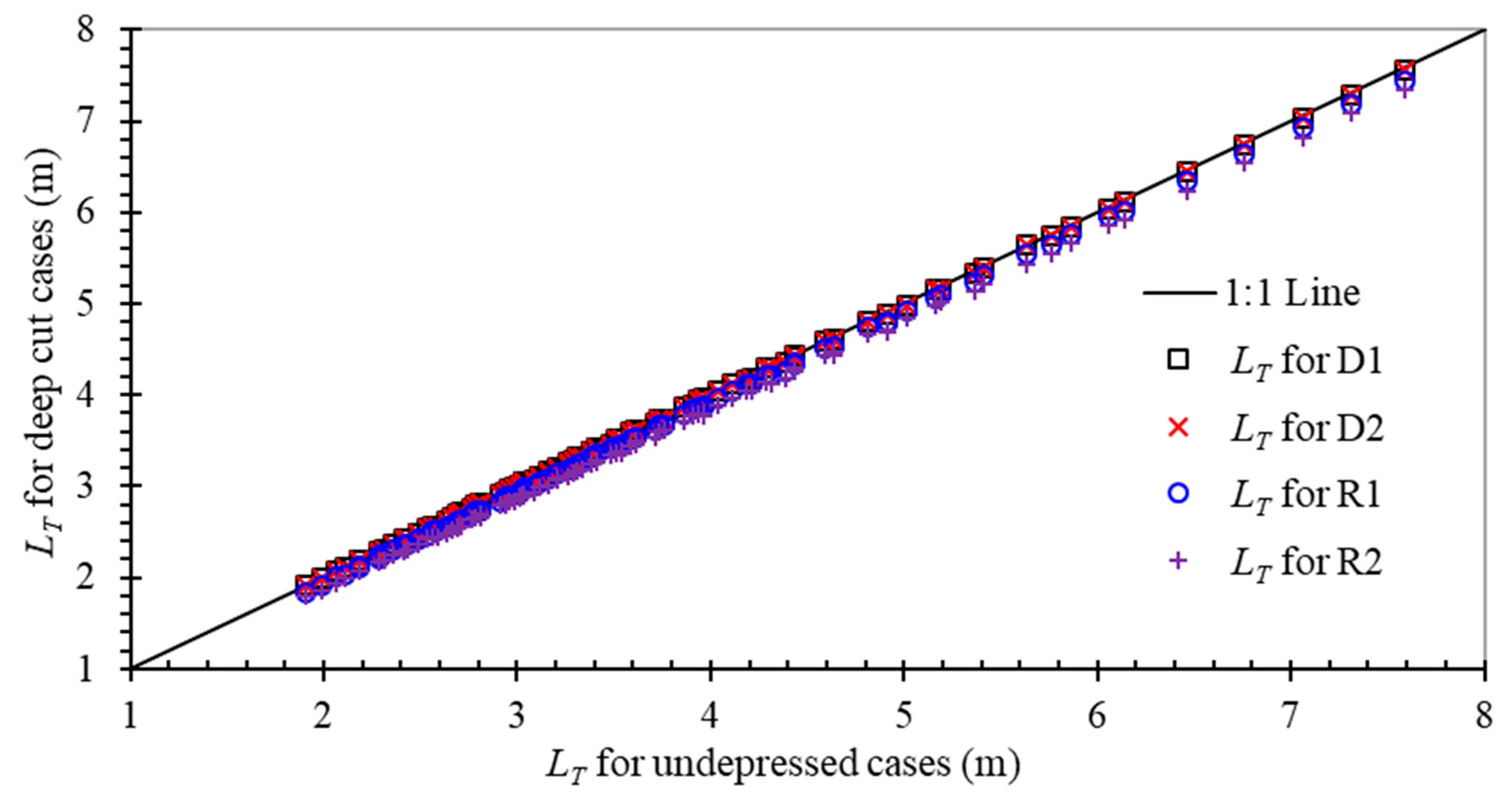

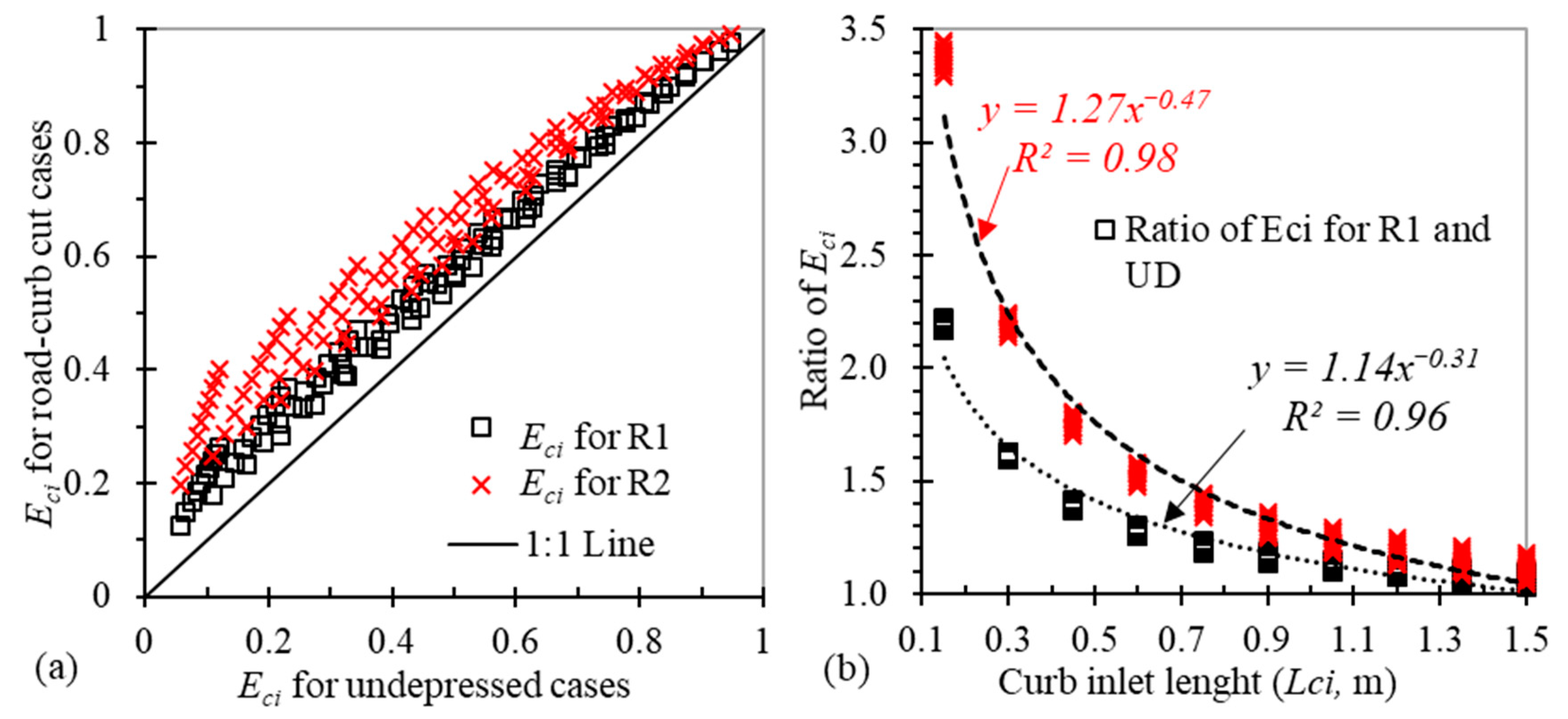
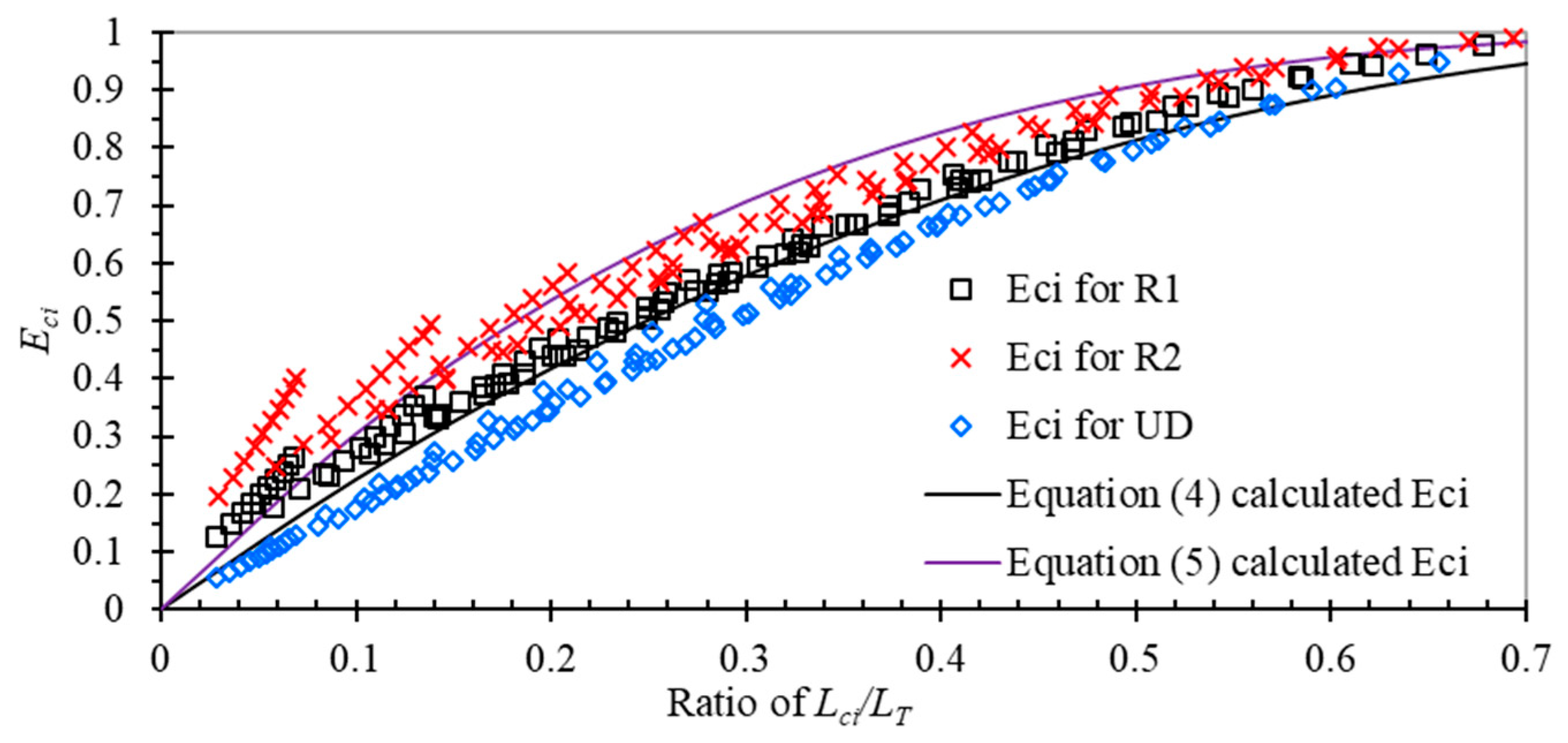
| Sequence No. | Sx (%) | Modeling Case Index 1 | Modeling Case Index 2 | Qin (L/s) | Modeling Case Index 3 | Modeling Case Index 4 | Lci (m) |
|---|---|---|---|---|---|---|---|
| 1 | 1.5 | UDX1Q1 | D1X1Q1 | 6 | UDX1L1 | D1X1L1 | 0.15 |
| 2 | 2.0 | UDX2Q2 | D1X2Q2 | 8 | UDX2L2 | D1X2L2 | 0.30 |
| 3 | 2.5 | UDX3Q3 | D1X3Q3 | 10 | UDX3L3 | D1X3L3 | 0.45 |
| 4 | 3.0 | UDX4Q4 | D1X4Q4 | 12 | UDX4L4 | D1X4L4 | 0.60 |
| 5 | 3.5 | UDX5Q5 | D1X5Q5 | 14 | UDX5L5 | D1X5L5 | 0.75 |
| 6 | 4.0 | UDX6Q6 | D1X6Q6 | 16 | UDX6L6 | D1X6L6 | 0.90 |
| 7 | 4.5 | UDX7Q7 | D1X7Q7 | 18 | UDX7L7 | D1X7L7 | 1.05 |
| 8 | 5.0 | UDX8Q8 | D1X8Q8 | 20 | UDX8L8 | D1X8L8 | 1.20 |
| 9 | 5.5 | UDX9Q9 | D1X9Q9 | 22 | UDX9L9 | D1X9L9 | 1.35 |
| 10 | 6.0 | UDX10Q10 | D1X10Q10 | 24 | UDX10L10 | D1X10L10 | 1.50 |
| Sequence No. | Sx (%) | Modeling Case Index 1 | Qin (L/s) | Modeling Case Index 2 | Lci (m) |
|---|---|---|---|---|---|
| 1 | 1.5 | R1X1Q1 | 6 | R1X1L1 | 0.15 |
| 2 | 2.0 | R1X2Q2 | 8 | R1X2L2 | 0.30 |
| 3 | 2.5 | R1X3Q3 | 10 | R1X3L3 | 0.45 |
| 4 | 3.0 | R1X4Q4 | 12 | R1X4L4 | 0.60 |
| 5 | 3.5 | R1X5Q5 | 14 | R1X5L5 | 0.75 |
| 6 | 4.0 | R1X6Q6 | 16 | R1X6L6 | 0.90 |
| 7 | 4.5 | R1X7Q7 | 18 | R1X7L7 | 1.05 |
| 8 | 5.0 | R1X8Q8 | 20 | R1X8L8 | 1.20 |
| 9 | 5.5 | R1X9Q9 | 22 | R1X9L9 | 1.35 |
| 10 | 6.0 | R1X10Q10 | 24 | R1X10L10 | 1.50 |
Publisher’s Note: MDPI stays neutral with regard to jurisdictional claims in published maps and institutional affiliations. |
© 2020 by the authors. Licensee MDPI, Basel, Switzerland. This article is an open access article distributed under the terms and conditions of the Creative Commons Attribution (CC BY) license (http://creativecommons.org/licenses/by/4.0/).
Share and Cite
Li, X.; Wang, C.; Chen, G.; Wang, Q.; Hu, Z.; Wu, J.; Wang, S.; Fang, X. Evaluating Efficiency Improvement of Deep-Cut Curb Inlets for Road-Bioretention Stripes. Water 2020, 12, 3368. https://doi.org/10.3390/w12123368
Li X, Wang C, Chen G, Wang Q, Hu Z, Wu J, Wang S, Fang X. Evaluating Efficiency Improvement of Deep-Cut Curb Inlets for Road-Bioretention Stripes. Water. 2020; 12(12):3368. https://doi.org/10.3390/w12123368
Chicago/Turabian StyleLi, Xiaoning, Chuanhai Wang, Gang Chen, Qiang Wang, Zunle Hu, Jinning Wu, Shan Wang, and Xing Fang. 2020. "Evaluating Efficiency Improvement of Deep-Cut Curb Inlets for Road-Bioretention Stripes" Water 12, no. 12: 3368. https://doi.org/10.3390/w12123368
APA StyleLi, X., Wang, C., Chen, G., Wang, Q., Hu, Z., Wu, J., Wang, S., & Fang, X. (2020). Evaluating Efficiency Improvement of Deep-Cut Curb Inlets for Road-Bioretention Stripes. Water, 12(12), 3368. https://doi.org/10.3390/w12123368







